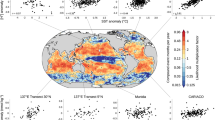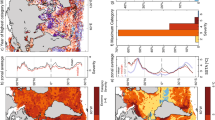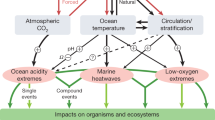Abstract
Marine heatwaves and ocean acidification extreme events are periods during which temperature and acidification reach statistically extreme levels (90th percentile), relative to normal variability, potentially endangering ecosystems. As the threats from marine heatwaves and ocean acidification extreme events grow with climate change, there is need for skilful predictions of events months to years in advance. Previous work has demonstrated that climate models can predict marine heatwaves up to 12 months in advance in key regions, but forecasting of ocean acidification extreme events has been difficult due to the complexity of the processes leading to extremes and sparse observations. Here we use the Community Earth System Model Seasonal-to-Multiyear Large Ensemble to make predictions of marine heatwaves and two forms of ocean acidification extreme events, as defined by anomalies in hydrogen ion concentration and aragonite saturation state. We show that the ensemble skilfully predicts marine heatwaves and ocean acidification extreme events as defined by aragonite saturation state up to 1 year in advance. Predictive skill for ocean acidification extremes as defined by hydrogen ion concentration is lower, probably reflecting mismatch between model and observed state. Skill is highest in the eastern Pacific, reflecting the predictable contribution of El Niño/Southern Oscillation to regional variability. A forecast generated in late 2023 during the 2023–2024 El Niño event finds high likelihood for widespread marine heatwaves and ocean acidification extreme events in 2024.
This is a preview of subscription content, access via your institution
Access options
Access Nature and 54 other Nature Portfolio journals
Get Nature+, our best-value online-access subscription
$32.99 / 30 days
cancel any time
Subscribe to this journal
Receive 12 print issues and online access
$259.00 per year
only $21.58 per issue
Buy this article
- Purchase on SpringerLink
- Instant access to full article PDF
Prices may be subject to local taxes which are calculated during checkout




Similar content being viewed by others
Data availability
The CESM Seasonal to Multiyear Large Ensemble and SMYLE FOSI are available at https://doi.org/10.26024/pwma-re41 (ref. 39). OceanSODA-ETHZ can be accessed at https://doi.org/10.25921/m5wx-ja34 (ref. 61).
Code availability
All figures were generated with the open-source software Python. Code used in processing and analysing CESM SMYLE output relative to SMYLE FOSI and OceanSODA-ETHZ can be found at https://doi.org/10.5281/zenodo.12103992 (ref. 71).
References
Doney, S. C., Fabry, V. J., Feely, R. A. & Kleypas, J. A. Ocean acidification: the other CO2 problem. Annu Rev. Mar. Sci. 1, 169–192 (2009).
Bopp, L. et al. Multiple stressors of ocean ecosystems in the 21st century: projections with CMIP5 models. Biogeosciences 10, 6225–6245 (2013).
Kwiatkowski, L. & Orr, J. C. Diverging seasonal extremes for ocean acidification during the twenty-first century. Nat. Clim. Chang. 8, 141–145 (2018).
Heinze, C. et al. Reviews and syntheses: abrupt ocean biogeochemical change under human-made climatic forcing—warming, acidification, and deoxygenation. Preprint at Biogeosci. Discuss. https://doi.org/10.5194/bg-2023-182 (2023).
Mogen, S. C. et al. Ocean biogeochemical signatures of the North Pacific Blob. Geophys. Res. Lett. https://doi.org/10.1029/2021GL096938 (2022).
Frölicher, T. L. & Laufkötter, C. Emerging risks from marine heat waves. Nat. Commun. 9, 650 (2018).
Kohlman, C. et al. The 2019 marine heatwave at Ocean Station Papa: a multi-disciplinary assessment of ocean conditions and impacts on marine ecosystems. J. Geophys. Res. Oceans https://doi.org/10.1029/2023JC020167 (2024).
Jacox, M. G. et al. Global seasonal forecasts of marine heatwaves. Nature 604, 486–490 (2022).
Hobday, A. J. et al. A hierarchical approach to defining marine heatwaves. Prog. Oceanogr. 141, 227–238 (2016).
Holbrook, N. J. et al. A global assessment of marine heatwaves and their drivers. Nat. Commun. 10, 2624 (2019).
Di Lorenzo, E. & Mantua, N. Multi-year persistence of the 2014/15 North Pacific marine heatwave. Nat. Clim. Chang. 6, 1042–1047 (2016).
Amaya, D. J., Miller, A. J., Xie, S.-P. & Kosaka, Y. Physical drivers of the summer 2019 North Pacific marine heatwave. Nat. Commun. 11, 1903 (2020).
Scannell, H. et al. Spatiotemporal evolution of marine heatwaves globally. Preprint at ESS Open Archive https://doi.org/10.22541/essoar.169008275.57053412/v1 (2023).
Guo, X. et al. Threat by marine heatwaves to adaptive large marine ecosystems in an eddy-resolving model. Nat. Clim. Chang. 12, 179–186 (2022).
Wyatt, A. M., Resplandy, L. & Marchetti, A. Ecosystem impacts of marine heat waves in the northeast Pacific. Biogeosciences 19, 5689–5705 (2022).
Rühmkorff, S. et al. Marine heatwaves and upwelling shape stress responses in a keystone predator. Proc. R. Soc. B 290, 20222262 (2023).
Welch, H. et al. Impacts of marine heatwaves on top predator distributions are variable but predictable. Nat. Commun. 14, 5188 (2023).
Smale, D. A. et al. Marine heatwaves threaten global biodiversity and the provision of ecosystem services. Nat. Clim. Chang. 9, 306–312 (2019).
Fragkopoulou, E. et al. Marine biodiversity exposed to prolonged and intense subsurface heatwaves. Nat. Clim. Chang. https://doi.org/10.1038/s41558-023-01790-6 (2023).
Hauri, C. et al. Spatiotemporal variability and long-term trends of ocean acidification in the California Current System. Biogeosciences 10, 193–216 (2013).
Hauri, C., Friedrich, T. & Timmermann, A. Abrupt onset and prolongation of aragonite undersaturation events in the Southern Ocean. Nat. Clim. Chang. 6, 172–176 (2016).
Burger, F. A., John, J. G. & Frölicher, T. L. Increase in ocean acidity variability and extremes under increasing atmospheric CO2. Biogeosciences 17, 4633–4662 (2020).
Burger, F. A. & Frölicher, T. L. Drivers of surface ocean acidity extremes in an Earth system model. Global Biogeochem. Cycles 37, e2023GB007785 (2023).
Desmet, F., Gruber, N., Köhn, E. E., Münnich, M. & Vogt, M. Tracking the space–time evolution of ocean acidification extremes in the California Current System and Northeast Pacific. J. Geophys. Res. Oceans https://doi.org/10.1029/2021JC018159 (2022).
Wong, J., Münnich, M. & Gruber, N. Column-compound extremes in the global ocean. AGU Adv. AGU Adv. 5, e2023AV001059 (2024).
Mucci, A. The solubility of calcite and aragonite in seawater at various salinities, temperatures, and one atmosphere total pressure. Am. J. Sci. 283, 780–799 (1983).
Ries, J. B., Cohen, A. L. & McCorkle, D. C. Marine calcifiers exhibit mixed responses to CO2-induced ocean acidification. Geology 37, 1131–1134 (2009).
Bednaršek, N. et al. Systematic review and meta-analysis toward synthesis of thresholds of ocean acidification impacts on calcifying pteropods and interactions with warming. Front Mar. Sci. 6, 227 (2019).
Negrete-García, G., Lovenduski, N. S., Hauri, C., Krumhardt, K. M. & Lauvset, S. K. Sudden emergence of a shallow aragonite saturation horizon in the Southern Ocean. Nat. Clim. Chang. 9, 313–317 (2019).
Bednaršek, N., Harvey, C. J., Kaplan, I. C., Feely, R. A. & Možina, J. Pteropods on the edge: cumulative effects of ocean acidification, warming, and deoxygenation. Prog. Oceanogr. 145, 1–24 (2016).
Bednaršek, N. et al. El Niño-related thermal stress coupled with upwelling-related ocean acidification negatively impacts cellular to population-level responses in pteropods along the California Current System with implications for increased bioenergetic costs. Front Mar. Sci. 5, 486 (2018).
Bednaršek, N. et al. Exposure history determines pteropod vulnerability to ocean acidification along the US West Coast. Sci. Rep. 7, 4526 (2017).
Bednaršek, N. et al. Integrated assessment of ocean acidification risks to pteropods in the northern high latitudes: regional comparison of exposure, sensitivity and adaptive capacity. Front Mar. Sci. 8, 671497 (2021).
Manno, C., Peck, V. L. & Tarling, G. A. Pteropod eggs released at high \(p_{{\mathrm{CO}}_2}\) lack resilience to ocean acidification. Sci. Rep. 6, 25752 (2016).
Stock, C. A. et al. Seasonal sea surface temperature anomaly prediction for coastal ecosystems. Prog. Oceanogr. 137, 219–236 (2015).
Mogen, S. C. et al. Skillful multi-month predictions of ecosystem stressors in the surface and subsurface ocean. Earths Future 11, e2023EF003605 (2023).
Brady, R. X., Lovenduski, N. S., Yeager, S. G., Long, M. C. & Lindsay, K. Skillful multiyear predictions of ocean acidification in the California Current System. Nat. Commun. 11, 2166 (2020).
McAdam, R., Masina, S. & Gualdi, S. Seasonal forecasting of subsurface marine heatwaves. Commun. Earth Environ. 4, 225 (2023).
Yeager, S. G. et al. The Seasonal-to-Multiyear Large Ensemble (SMYLE) prediction system using the Community Earth System Model version 2. Geosci. Model Dev. 15, 6451–6493 (2022).
Jacox, M. G. et al. Seasonal-to-interannual prediction of North American coastal marine ecosystems: forecast methods, mechanisms of predictability, and priority developments. Prog. Oceanogr. 183, 102307 (2020).
Capotondi, A., Sardeshmukh, P. D., Di Lorenzo, E., Subramanian, A. C. & Miller, A. J. Predictability of US West Coast ocean temperatures is not solely due to ENSO. Sci. Rep. 9, 10993 (2019).
Capotondi, A., Newman, M., Xu, T. & Di Lorenzo, E. An optimal precursor of Northeast Pacific marine heatwaves and Central Pacific El Niño events. Geophys. Res. Lett. 49, e2021GL097350 (2022).
Ren, X., Liu, W., Capotondi, A., Amaya, D. J. & Holbrook, N. J. The Pacific Decadal Oscillation modulated marine heatwaves in the Northeast Pacific during past decades. Commun. Earth Environ. 4, 218 (2023).
Sarmiento, J. L. & Gruber, N. Ocean Biogeochemical Dynamics (Princeton Univ. Press, 2013); http://www.jstor.org/stable/10.2307/j.ctt3fgxqx
Lovenduski, N. S. et al. The potential impact of nuclear conflict on ocean acidification. Geophys Res Lett. 47, e2019GL086246 (2020).
Reynolds, R. W. et al. Daily high-resolution-blended analyses for sea surface temperature. J. Clim. 20, 5473–5496 (2007).
NOAA Earth System Research Laboratory. Niño3.4, https://stateoftheocean.osmc.noaa.gov/sur/pac/nino34.php (2024).
Lilly, L. E. et al. Biogeochemical anomalies at two Southern California Current System moorings during the 2014–2016 Warm Anomaly–El Niño sequence. J. Geophys Res. Oceans 124, 6886–6903 (2019).
Mills, K. E. et al. in Ocean Ecosystems and Marine Resources (eds Crimmins, A. et al.) (US Global Change Research Program, 2023).
NOAA Physical Sciences Laboratory. Marine Heatwaves Forecast, https://psl.noaa.gov/marine-heatwaves/#forecasts (2024).
Mercator Ocean International. Marine Heatwave Bulletin, https://www.mercator-ocean.eu/en/category/mhw-bulletin/ (2024).
Siedlecki, S. A. et al. Experiments with seasonal forecasts of ocean conditions for the northern region of the California Current upwelling system. Sci. Rep. 6, 27203 (2016).
Brodie, S. et al. Ecological forecasts for marine resource management during climate extremes. Nat. Commun. 14, 7701 (2023).
Moore, J. K., Doney, S. C., Kleypas, J. A., Glover, D. M. & Fung, I. Y. An intermediate complexity marine ecosystem model for the global domain. Deep Sea Res. 2 49, 403–462 (2001).
Moore, J. K., Doney, S. C. & Lindsay, K. Upper ocean ecosystem dynamics and iron cycling in a global three-dimensional model. Global Biogeochem. Cycles 18, GB4028 (2004).
Moore, J. K., Lindsay, K., Doney, S. C., Long, M. C. & Misumi, K. Marine ecosystem dynamics and biogeochemical cycling in the Community Earth System Model [CESM1(BGC)]: comparison of the 1990s with the 2090s under the RCP4.5 and RCP8.5 scenarios. J. Clim. 26, 9291–9312 (2013).
Long, M. C. et al. Simulations with the Marine Biogeochemistry Library (MARBL). J. Adv. Model. Earth Syst. https://doi.org/10.1029/2021MS002647 (2021).
Tsujino, H. et al. JRA-55 based surface dataset for driving ocean–sea-ice models (JRA55-do). Ocean Model. 130, 79–139 (2018).
Bakker, D. C. E. et al. A multi-decade record of high-quality fCO2 data in version 3 of the Surface Ocean CO2 Atlas (SOCAT). Earth Syst. Sci. Data 8, 383–413 (2016).
Olsen, A. et al. GLODAPv2.2019—an update of GLODAPv2. Earth Syst. Sci. Data 11, 1437–1461 (2019).
Gregor, L. & Gruber, N. OceanSODA-ETHZ: a global gridded data set of the surface ocean carbonate system for seasonal to decadal studies of ocean acidification. Earth Syst. Sci. Data 13, 777–808 (2021).
Humphreys, M. P., Lewis, E. R., Sharp, J. D. & Pierrot, D. PyCO2SYS v1.7: marine carbonate system calculations in Python. Geosci. Model Dev. https://doi.org/10.5194/gmd-2021-159 (2022).
Good, S., Embury, O., Bulgin, C. & Mittaz, J. ESA Sea Surface Temperature Climate Change Initiative (SST_cci): Level 4 Analysis Climate Data Record Version 2.0 (CEDA, 2019); https://catalogue.ceda.ac.uk/uuid/aced40d7cb964f23a0fd3e85772f2d48
Good, S. et al. The current configuration of the OSTIA system for operational production of foundation sea surface temperature and ice concentration analyses. Remote Sens. 12, 720 (2020).
Ma, D., Gregor, L. & Gruber, N. Four decades of trends and drivers of global surface ocean acidification. Global Biogeochem. Cycles 37, e2023GB007765 (2023).
Amaya, D. J. et al. Marine heatwaves need clear definitions so coastal communities can adapt. Nature 616, 29–32 (2023).
Hauri, C. et al. More than marine heatwaves: a new regime of heat, acidity, and low oxygen compound extreme events in the Gulf of Alaska. AGU Adv. 5, e2023AV001039 (2024).
Gruber, N., Boyd, P. W., Frölicher, T. L. & Vogt, M. Biogeochemical extremes and compound events in the ocean. Nature 600, 395–407 (2021).
Marshall, A. G. et al. Intra-seasonal drivers of extreme heat over Australia in observations and POAMA-2. Clim. Dyn. 43, 1915–1937 (2014).
Ferro, C. A. T. & Stephenson, D. B. Extremal dependence indices: improved verification measures for deterministic forecasts of rare binary events. Weather Forecast. 26, 699–713 (2011).
Mogen, S. Marine extreme forecasting in CESM SMYLE (multi-month forecasts of marine heatwaves and ocean acidification extremes). Zenodo https://doi.org/10.5281/zenodo.12103992 (2024).
Acknowledgements
S.M. and N.S.L. were supported by the National Science Foundation (OCE 1752724) and the National Oceanic and Atmospheric Administration (NA20OAR4310405). M.P.B. was supported by the National Oceanic and Atmospheric Administration (NA20OAR4310405). S.J.Y. and N.R. acknowledge support from the Regional and Global Model Analysis (RGMA) component of the Earth and Environmental System Modeling Program of the US Department of Energy’s Office of Biological and Environmental Research (BER) under award number DE-SC0022070. W.K. and S.J.Y. acknowledge the support of NOAA Climate Program Office’s CVP programme under grant no. NA20OAR4310408. A.C. was supported by the NOAA Climate Program Office’s MAPP programme, DOE Award no. DE-SC0023228, and NASA Physical Oceanography grant no. 80NSSC21K0556. This work also was supported by the National Center for Atmospheric Research, which is a major facility sponsored by the National Science Foundation (NSF) under Cooperative Agreement no. 1852977. We thank the National Center for Atmospheric Research Earth System Working Group for their development of invaluable software tools used in processing CESM SMYLE: https://github.com/CESM-ESPWG/ESP-Lab. We are grateful for helpful feedback from D. Amaya.
Author information
Authors and Affiliations
Contributions
S.M. and N.S.L. designed the study. S.M. performed the analysis. All authors contributed to interpretation of the results. S.M. and N.S.L. wrote the manuscript with input from all authors.
Corresponding author
Ethics declarations
Competing interests
The authors declare no competing interests.
Peer review
Peer review information
Nature Geoscience thanks Filippa Fransner, James Orr and the other, anonymous, reviewer(s) for their contribution to the peer review of this work. Primary Handling Editor: James Super, in collaboration with the Nature Geoscience team.
Additional information
Publisher’s note Springer Nature remains neutral with regard to jurisdictional claims in published maps and institutional affiliations.
Extended data
Extended Data Fig. 1 Different skill metrics (SEDI, Forecast Accuracy, Brier Skill Score) at lead-time 3.5 months.
Forecast skill calculated by three different metrics at lead-time 3.5 months. SEDI (as in Fig. 1) (row 1; a,b,c), Forecast Accuracy (row 2; d,e,f), and Brier Skill Score (BSS) (row 3: g,h,i) for marine heatwaves (column 1), ocean acidification extremes (Ωa), and ocean acidification extremes ([H+]).
Extended Data Fig. 2 Number, duration, and intensity of extremes in CESM SMYLE and observations.
Number per month (row 1; a,b,c), duration (row 2; d,e,f), and intensity (row 3; g,h,i) of the average extreme event in observations and CESM SMYLE for marine heatwaves (column 1), ocean acidification extremes (Ωa) (column 2), and ocean acidification extremes ([H+]) (column 3) at each location.
Extended Data Fig. 3 Correlation between historically observed and modelled variability and extremes.
Correlation coefficient between historical (column 1) variability of (a) sea surface temperature, (c) Ωa, (e) [H+] and (column 2) extremes (b) marine heatwaves, (d) ocean acidification extremes (Ωa),(f) ocean acidification extremes ([H+]) in SMYLE FOSI and observations (OceanSODA-ETHZ). Higher correlation coefficients indicate more similar historical variability or extreme events.
Extended Data Fig. 4 Model skill (CESM SMYLE relative to observations) and model predictability (CESM SMYLE relative to SMYLE FOSI).
Comparison of (column 1) model skill (CESM SMYLE relative to observations) and (column 2) model predictability (CESM SMYLE relative to SMYLE FOSI) for 20 ensemble members from CESM SMYLE at 1.5 (a-b), 3.5 (c-d), 6.5 (e-f), and 10.5 month lead-time (g-h). Skill scores range from -1 to 1, with SEDI score close to -1 being unskillful, SEDI score of 0 being no better than random forecasts, and SEDI score of 1 being perfect skill.
Extended Data Fig. 5 Decomposition and drivers of extremes in aragonite saturation state.
Decomposition of Ωa to determine drivers of extreme events. (row 1) Decomposition of [CO3]2- into drivers of changes during extremes relative to all times, including effects of (a) temperature, (b) salinity, (c) DIC, (d) Alkalinity. (row 2) Changes to tendency terms of DIC during extremes relative to all times, including: (e) total DIC tendency, (f) circulation tendency, (g) air-sea CO2 flux tendency, and (h) biological tendency.
Extended Data Fig. 6 Example forecast of aragonite saturation state extreme events from the 1999 La Niña.
Forecasts of Ωa initialized during the August 1999 La Niña event. Anomalies (color) and extremes (hatching) in (column 1) from an interpolated observational product (OceanSODA-ETHZ), and (column 2) CESM SMYLE forecasts (a,b) 1.5, (c,d) 3.5, and (e,f) 5.5 months after initialization. Extreme events are defined in observations (below the 10th percentile) and in CESM SMYLE (below the 10th percentile in a minimum of 50% of ensemble members).
Extended Data Fig. 7 Example forecast of aragonite saturation state extremes in the tropical Pacific from 2004-2012.
Example timeseries of Ωa anomalies in the central tropical Pacific (0.5∘N, 138.5∘W) for (black) SMYLE FOSI and (grey) two November CESM SMYLE initializations (2006a and 2009; with ensemble spread represented) from 2006-2012. Occurrence of extreme events are indicated for (red lines) SMYLE FOSI and (bar plot) CESM SMYLE (as a percentage of ensemble members).
Extended Data Fig. 8 Magnitude of variability associated with trend (per decade), climatology, interannual variability, and extreme event anomaly for aragonite saturation state.
Relative magnitude of anomalies associated with (row 1; a,b) trend (per decade), (row 2; c,d) seasonal climatology, (row 3; e,f) interannual variability, and (row 4; g,h) mean strength of anomaly to generate extreme event for temperature and Ωa.
Rights and permissions
Springer Nature or its licensor (e.g. a society or other partner) holds exclusive rights to this article under a publishing agreement with the author(s) or other rightsholder(s); author self-archiving of the accepted manuscript version of this article is solely governed by the terms of such publishing agreement and applicable law.
About this article
Cite this article
Mogen, S.C., Lovenduski, N.S., Yeager, S.G. et al. Multi-month forecasts of marine heatwaves and ocean acidification extremes. Nat. Geosci. 17, 1261–1267 (2024). https://doi.org/10.1038/s41561-024-01593-0
Received:
Accepted:
Published:
Issue date:
DOI: https://doi.org/10.1038/s41561-024-01593-0



